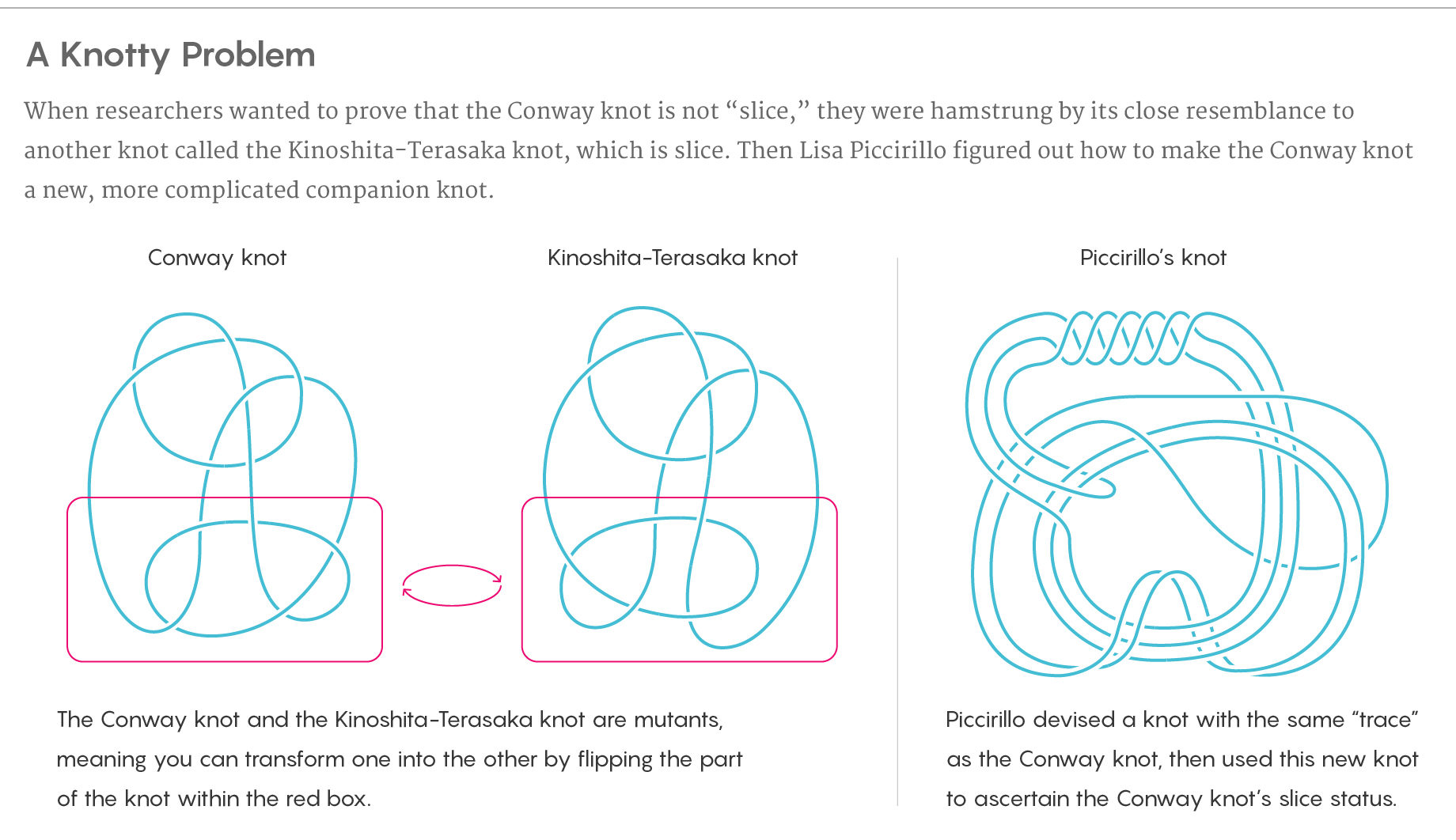
In the summer of 2018, at a conference on low-dimensional topology and geometry, Lisa Piccirillo heard about a nice little math problem. It seemed like a good testing ground for some techniques she had been developing as a graduate student at the University of Texas, Austin.
"I didn't allow myself to work on it during the day," she said, "because I didn't consider it to be real math. I thought it was, like, my homework."
The question asked whether the Conway knot — a snarl discovered more than half a century ago by the legendary mathematician John Horton Conway — is a slice of a higher-dimensional knot. "Sliceness" is one of the first natural questions knot theorists ask about knots in higher-dimensional spaces, and mathematicians had been able to answer it for all of the thousands of knots with 12 or fewer crossings — except one. The Conway knot, which has 11 crossings, had thumbed its nose at mathematicians for decades.
Before the week was out, Piccirillo had an answer: The Conway knot is not "slice." A few days later, she met with Cameron Gordon, a professor at UT Austin, and casually mentioned her solution.
"I said, 'What?? That's going to the Annals right now!'" Gordon said, referring to Annals of Mathematics, one of the discipline's top journals.
"He started yelling, 'Why aren't you more excited?'" said Piccirillo, now a postdoctoral fellow at Brandeis University. "He sort of freaked out."
"I don't think she'd recognized what an old and famous problem this was," Gordon said.
Piccirillo's proof appeared in Annals of Mathematics in February. The paper, combined with her other work, has secured her a tenure-track job offer from the Massachusetts Institute of Technology that will begin on July 1, only 14 months after she finished her doctorate.
The question of the Conway knot's sliceness was famous not just because of how long it had gone unsolved. Slice knots give mathematicians a way to probe the strange nature of four-dimensional space, in which two-dimensional spheres can be knotted, sometimes in such crumpled ways that they can't be smoothed out. Sliceness is "connected to some of the deepest questions in four-dimensional topology right now," said Charles Livingston, an emeritus professor at Indiana University.
"This question, whether the Conway knot is slice, had been kind of a touchstone for a lot of the modern developments around the general area of knot theory," said Joshua Greene of Boston College, who supervised Piccirillo's senior thesis when she was an undergraduate there. "It was really gratifying to see somebody I'd known for so long suddenly pull the sword from the stone."
Magic Spheres
While most of us think of a knot as existing in a piece of string with two ends, mathematicians think of the two ends as joined, so the knot can't unravel. Over the past century, these knotted loops have helped illuminate subjects from quantum physics to the structure of DNA, as well as the topology of three-dimensional space.
But our world is four-dimensional if we include time as a dimension, so it is natural to ask if there is a corresponding theory of knots in 4D space. This isn't just a matter of taking all the knots we have in 3D space and plunking them down in 4D space: With four dimensions to move around in, any knotted loop can be unraveled if strands are moved over each other in the fourth dimension.
To make a knotted object in four-dimensional space, you need a two-dimensional sphere, not a one-dimensional loop. Just as three dimensions provide enough room to build knotted loops but not enough room for them to unravel, four dimensions provide such an environment for knotted spheres, which mathematicians first constructed in the 1920s.
It's hard to visualize a knotted sphere in 4D space, but it helps to first think about an ordinary sphere in 3D space. If you slice through it, you'll see an unknotted loop. But when you slice through a knotted sphere in 4D space, you might see a knotted loop instead (or possibly an unknotted loop or a link of several loops, depending on where you slice). Any knot you can make by slicing a knotted sphere is said to be "slice." Some knots are not slice — for instance, the three-crossing knot known as the trefoil.
Slice knots "provide a bridge between the three-dimensional and four-dimensional stories of knot theory," Greene said.
But there's a wrinkle that lends richness and peculiarity to the four-dimensional story: In 4D topology, there are two different versions of what it means to be slice. In a series of revolutionary developments in the early 1980s (which earned both Michael Freedman and Simon Donaldson Fields Medals), mathematicians discovered that 4D space doesn't just contain the smooth spheres we intuitively visualize — it also contains spheres so pervasively crumpled that they could never be ironed smooth. The question of which knots are slice depends on whether you choose to include these crumpled spheres.
"These are very, very strange objects, that sort of exist by magic," said Shelly Harvey of Rice University. (It was at Harvey's talk in 2018 that Piccirillo first learned about the Conway knot problem.)
These strange spheres are not a bug of four-dimensional topology, but a feature. Knots that are "topologically slice" but not "smoothly slice" — meaning they are a slice of some crumpled sphere, but no smooth one — allow mathematicians to build so-called "exotic" versions of ordinary four-dimensional space. These copies of four-dimensional space look the same as normal space from a topological viewpoint but are irretrievably crumpled. The existence of these exotic spaces sets dimension four apart from all other dimensions.
The question of sliceness is "the lowest-dimensional probe" of these exotic four-dimensional spaces, Greene said.
Over the years, mathematicians discovered an assortment of knots that were topologically but not smoothly slice. Among knots with 12 or fewer crossings, however, there didn't seem to be any — except possibly the Conway knot. Mathematicians could figure out the slice status of all other knots with 12 or fewer crossings, but the Conway knot eluded them.
Conway, who died of COVID-19 last month, was famous for making influential contributions to one area of mathematics after another. He first became interested in knots as a teenager in the 1950s and came up with a simple way to list essentially all the knots up to 11 crossings (previous complete lists had gone up to only 10 crossings).
On the list was one knot that stood out. "Conway, I think, realized that there was something quite special about it," Greene said.
The Conway knot, as it came to be known, is topologically slice — mathematicians realized this amid the revolutionary discoveries of the 1980s. But they couldn't figure out whether it was smoothly slice. They suspected that it was not, because it seemed to lack a feature called "ribbonness" that smoothly slice knots typically have. But it also had a feature that made it immune to every attempt to show it was not smoothly slice.
Namely, the Conway knot has a sort of sibling — what's known as a mutant. If you draw the Conway knot on paper, cut out a certain portion of the paper, flip the fragment over and then rejoin its loose ends, you get another knot known as the Kinoshita-Terasaka knot.
The trouble is, this new knot happens to be smoothly slice. And because the Conway knot is so closely related to a smoothly slice knot, it manages to hoodwink all the tools (called invariants) that mathematicians use to detect non-slice knots.
"Whenever a new invariant comes along, we try to test it against the Conway knot," Greene said. "It's just this one stubborn example that, it seems, no matter what invariant you come up with, it won't tell you whether or not the thing is slice."
The Conway knot "sits at the intersection of the blind spots" of these different tools, Piccirillo said.
One mathematician, Mark Hughes of Brigham Young University, created a neural network that uses knot invariants and other information to make predictions about features such as sliceness. For most knots, the network makes clear predictions. But its guess about whether the Conway knot is smoothly slice? Fifty-fifty.
"Over time it stood out as the knot that we couldn't handle," Livingston said.
Clever Twists
Piccirillo enjoys the visual intuition that knot theory entails, but she doesn't think of herself primarily as a knot theorist. "It's really [three- and four-dimensional shapes] that are exciting for me, but the study of these things is deeply linked with knot theory, so I do a bit of that too," she wrote in an email.
When she first started studying mathematics in college, she didn't stand out as a "standard golden child math prodigy," said Elisenda Grigsby, one of Piccirillo's professors at Boston College. Rather, it was Piccirillo's creativity that caught Grigsby's eye. "She believed very much in her own point of view, and always has."
Piccirillo encountered the question about the Conway knot at a time when she was pondering another way two knots can be related besides mutation. Every knot has an associated four-dimensional shape called its trace, which is made by placing the knot on the boundary of a 4D ball and sewing a sort of cap onto the ball along the knot. A knot's trace "encodes that knot in a very strong way," Gordon said.
Different knots can have the same four-dimensional trace, and mathematicians already knew that these trace siblings, so to speak, always have the same slice status — either they're both slice, or they're both not slice. But Piccirillo and Allison Miller, now a postdoctoral fellow at Rice, had shown that these trace siblings don't necessarily look the same to all the knot invariants used to study sliceness.
That pointed Piccirillo toward a strategy for proving that the Conway knot is not slice: If she could construct a trace sibling for the Conway knot, maybe it would cooperate with one of the slice invariants better than the Conway knot does.
Constructing trace siblings is a tricky business, but Piccirillo was an expert. "That's just, like, a trade I'm in," she said. "So I just went home and did it."
Through a combination of clever twists, Piccirillo managed to construct a complicated knot that has the same trace as the Conway knot. For that knot, a tool called Rasmussen's s-invariant shows it is not smoothly slice — so the Conway knot can't be either.
"It's a really beautiful proof," Gordon said. There was no reason to expect that the knot Piccirillo constructed would yield to Rasmussen's s-invariant, he said. "But it worked ... kind of amazingly."
Piccirillo's proof "fits into the mold of short, surprising proofs of elusive results that researchers in the area are able to quickly absorb, admire and seek to generalize — not to mention wonder how it took so long to come up with," Greene wrote in an email.
Knot traces are a classical tool that has been around for decades, but one that Piccirillo understood more deeply than anyone else, Greene said. Her work has shown topologists that knot traces are underappreciated, he said. "She's picked up some tools that maybe had a bit of dust on them," he said. "Others are following suit now."




Reader Comments
to our Newsletter